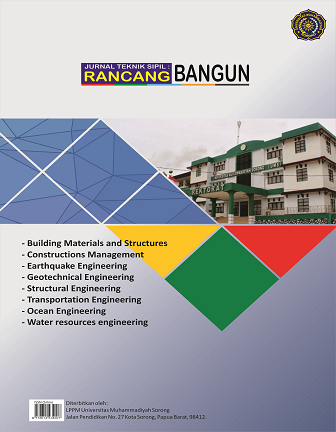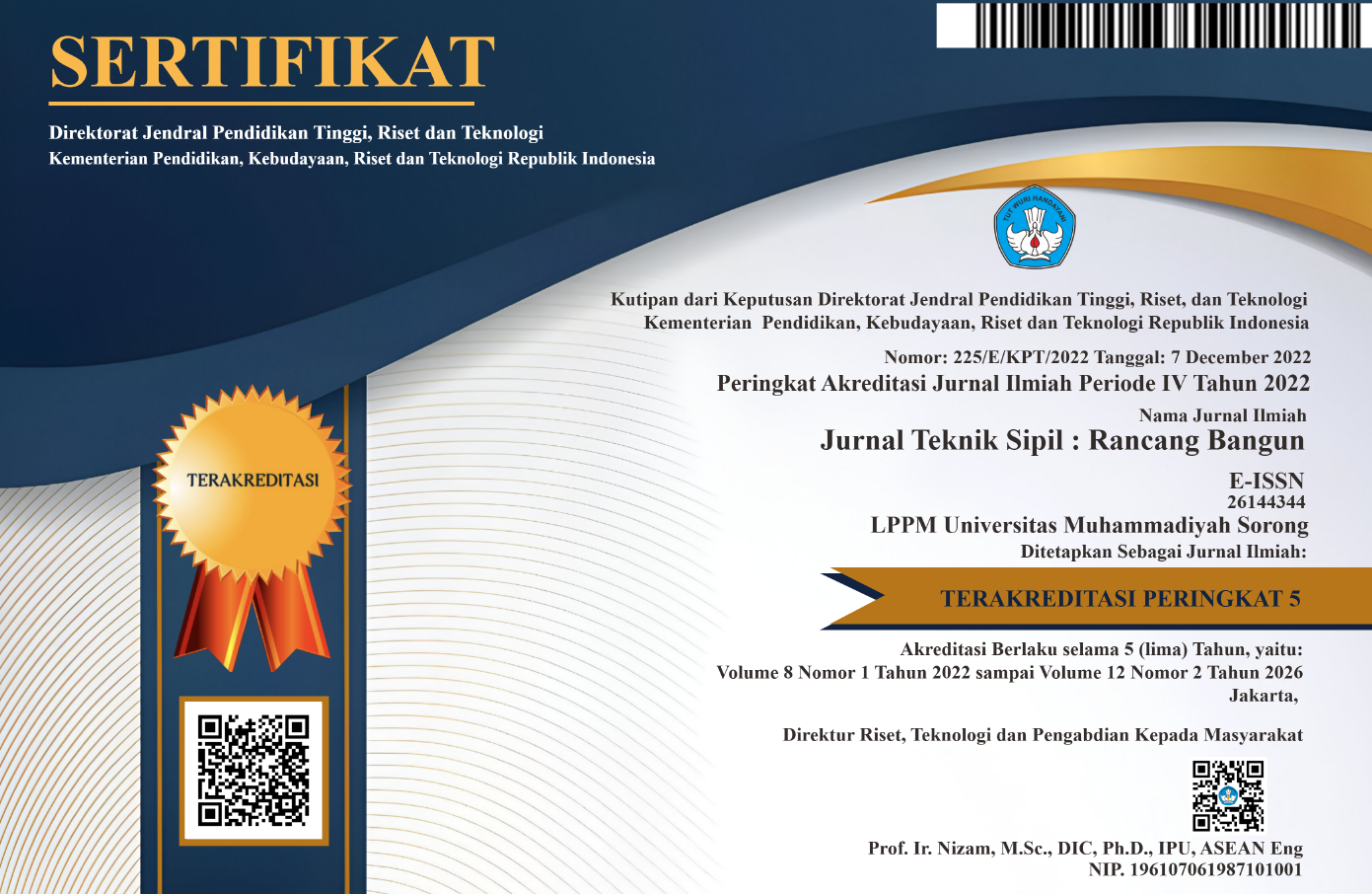EFEK PENAMBAHAN SERAT POLYPROPYLENE TERHADAP KUAT TEKAN BETON PADA PERKERASAN KAKU
Keywords:
Fiber Concrete, Compressive Strength, Polypropylene Fiber, WorkabilityAbstract
Rigid pavement or cement concrete pavement is a construction (pavement) with aggregate and raw materials and uses cement as a binding material. Rigid pavements have good compressive strength, but in contrast to flexural strength, this is due to their brittle nature, so when planning rigid pavements, fiber is added to the concrete mixture in the hope of increasing the elastic or flexible properties of the rigid pavement itself. This study aims to analyze the effect of adding polypropylene fibers to a mixture of rigid pavement concrete with a variation of 0.1%; 0.3%; 0.5%; 0.7%; and 1.0% by weight of cement. Control test objects without using polypropylene fiber. The number of cylindrical specimens of 15x30 cm was 30 pieces. Compressive strength test. The results showed that the compressive strength were optimum at 0.30%.
References
A S, M. R. (2006). Effect Of Polypropylene Fibers On The Mechanical Properties Of Normal Concrete. Journal of Engineering Sciences, 34(4), 1049–1059.
Abdulwahab, R., Akinleye, T. M., & Sahid Taiye, H. (2018). Effects of Polypropylene Fibre on The Compressive and Splitting Tensile Strength of Concrete. Journal of Materials and Engineering Structures, 5, 15–22.
Banthia, N., Yan, C., & Mindess, S. (1996). Restrained Shrinkage Cracking In Fiber Reinforced Concrete: A Novel Test Technique. Cement and Concrete Research, 26(1), 9–14.
Bingöl, F., & Atashafrazeh, M. (2015). Compressive Strength Of Polypropylene Fiber Concrete Under The Effects Of High Temperatures. International Journal of Modern Manufacturing Technologies, 7(1), 7–11.
Charishma, D., Deronika, P., & Malik, S. V. (2019). Study The Effect of Polypropylene Fiber in Concrete. Journal of Emerging Technologies and Innovative Research (JETIR) , 6(5), 1–8. www.jetir.org
Dharan, D. S., & Lal, A. (2016). Study The Effect of Polypropylene Fiber in Concrete. International Research Journal of Engineering and Technology, 3(6), 616–619. www.irjet.net
Gholami, M., Moghadas Nejad, F., Ramezanianpour, A. A., & Ramezanianpour, A. M. (2022). The Effect of Emboss Fiber (Modified Polypropylene Fiber) on the Behavior of Concrete used in Concrete Pavements. Amirkabir Journal of Civil Engineering, 54(2), 141–144. https://doi.org/10.22060/ceej.2021.19071.7054
Gu, Y., Meng, Y., Kong, L., & Wang, W. (2021). Effect of Polypropylene Fiber Admixture on Compressive Strength of Ceramsite Concrete. International Journal of Frontiers in Engineering Technology, 3(1), 20–26. https://doi.org/10.25236/ijfet.2021.030104
Jayaram, M., Naresh, J., Thipparthi, K., & Kastro Kiran, V. (2022). Assessment on mechanical properties of concrete with polypropylene fiber. IOP Conference Series: Earth and Environmental Science, 982(1). https://doi.org/10.1088/1755-1315/982/1/012004
Junaidi, A. (2015). Pemanfaatan Serat Bambu Untuk Meningkatkan Kuat Tekan Beton. Berkala Teknik, 5(1), 754.
Kabashi, N., Krasniqi, C., Hadri, R., & Sadikaj, A. (2018). Effect of Fibre Reinforced Concrete and Behaviour in Rigid Pavement. International Journal of Structural and Civil Engineering Research, 7(1), 29–33. https://doi.org/10.18178/ijscer.7.1.29-33
Khan, M. A. I. (2021). Strength Evaluation of Cement Concrete Pavement by Using Polypropylene and Polyester Fiber as Reinforced Material. International Journal of Creative Research Thoughts (IJCRT), 9(12), 192–197. www.ijcrt.org
Kumar, A., Hiremath, M., & Ramachandra, V. (2013). Improvement and Performance of Cement Concrete pavement using Polypropylene Fiber. International Journal of Engineering Research & Technology, 2(9), 1546–1568. www.ijert.org
Madhavi, T. C., Raju, L. S., & Mathur, D. (2014). International Journal of Emerging Technology and Advanced Engineering Polypropylene Fiber Reinforced Concrete-A Review. International Journal of Emerging Technology and Advanced Engineering, 4(4), 114–119. www.ijetae.com
Mashrei, M. A., Sultan, A., Mahdi, A. M., Mashrei, M. A., & Sultan, A. A. (2018). Effects of Polypropylene Fibers on Compressive and Flexural Strength of Concrete Material. Article in International Journal of Civil Engineering and Technology, 9(11), 2208–2217. http://www.iaeme.com/IJCIET/index.asp2208http://www.iaeme.com/ijciet/issues.asp?JType=IJCIET&VType=9&IType=11http://www.iaeme.com/IJCIET/issues.asp?JType=IJCIET&VType=9&IType=11
Megasari, S. W., Yanti, G., & Zainuri, Z. (2016). Karakteristik Beton Dengan Penambahan Limbah Serat Nylon Dan Polimer Concrete. SIKLUS: Jurnal Teknik Sipil, 2(1), 24–33.
Moustafa, M. A., Ibrahim, A. M. A., Ahmed, H. O., Khodary, F., & Hassanean, Y. A. (2021). Studying the Mechanical Properties of Rigid Pavement Reinforced with Single and Hybrid Fibers. Civil Engineering and Architecture, 9(6), 1877–1899. https://doi.org/10.13189/cea.2021.090620
N, I., K, T., TP, V., D, V., & Kumar M, S. (2017). Experimental Study On Polypropylene Reinforced Concrete Pavement. International Journal of Latest Engineering Research and Applications (IJLERA), 98–102. www.ijlera.com
Najimi, M., Farahani, F. M., & Pourkhorshidi, A. R. (2009). Effects Of Polypropylene Fibers On Physical And Mechanical Properties Of Concretes. 3rd International Conference on Concrete & Development, 1073–1081.
Neville, A. M., & Brooks, J. J. (1987). Concrete_Technology (Vol. 2).
Nurhidayatullah, E. F. (2019). Pengaruh Serat Baja Canai Dingin Bergelombang Terhadap Kekuatan Tekan Dan Lentur Beton. Jurnal Teknik Sipil: Rancang Bangun, 5(1), 1–12.
Patel, P. H., Juremalani, J., & Damodariya, S. M. (2016). Sustainable Development of Rigid Pavement by Using Polypropylene Fiber. International Journal of Scientific Research in Science, Engineering and Technology, 2(3), 196–200.
Pratiwi, S., Prayuda, H., & Prayuda, F. (2016). Kuat Tekan Beton Serat Menggunakan Variasi Fibre Optic dan Pecahan Kaca (Compressive Strength of Fibre Concrete Using Fibre Optic Variation and Glass Fracture). Semesta Teknika, 19(1), 55–67.
Sahrudin, S., & Nadia, N. (2016). Pengaruh Penambahan Serat Sabut Kelapa Terhadap Kuat Tekan Beton. Konstruksia, 7(2), 13–20.
Sheikh, T. A., & Mohit Bajaj, E. (2017). A Review Study Of Polymer Fibre Reinforced Concrete With Conventional Concrete Pavement. International Journal of Latest Research In Engineering and Computing (IJLREC), 5(3), 98–1000. www.ijlrec.com
SNI 03 2834, . (2002). Tata Cara Pembuatan Rencana Campuran Beton Normal.
SNI 03-1974. (2011). Metode Pengujian Kuat Tekan Beton. In Badan Standardisasi Nasional Indonesia.
SNI 1972. (2008). Cara uji slump beton. In Badan Standardisasi Nasional (p. 11).
Sultan, M. A., Hakim, R., Muchtar, B., & Adingku, J. (2022). Tinjauan Kuat Lentur Balok Beton Ringan Dengan Penambahan Serat Kawat. TERAS JURNAL, 12(2), 483. https://doi.org/10.29103/tj.v12i2.783
Sultan, M. A., Tuhuteru, E., & Abdullah, M. F. F. (2021). Kapasitas Lentur Balok Beton Ringan Dengan Penambahan Serat Ijuk. Jurnal Teknik Sipil Universitas Teuku Umar, 7(2), 163–171.
Wahyuni, A. S., & Elhusna. (2016). The Tensile Behaviour of Concrete with Natural Fiber from Sugar Palm Tree. International Conference on Engineering and Science for Research and Development (ICESReD), 15–18.
Yadav, S., Kanse, S. A., Gunjal, R. M., & Lad, R. R. (2022). Improving the Performance of Cement Concrete Pavement by using Polypropylene Fibers. International Journal of Research in Engineering, Science and Management, 5(5), 46–49.
Zollo, R. F. (1997). Fiber-reinforced Concrete: an Overview after 30 Years of Development. Cement and Concrete Compositer, 19, 107–122.
Downloads
Published
How to Cite
Issue
Section
License
Copyright (c) 2023 Thariq Al Faridzi A Sultan; Ismanto Wahab Ali; Abdul Gaus, Mufti Amir Sultan

This work is licensed under a Creative Commons Attribution-ShareAlike 4.0 International License.






